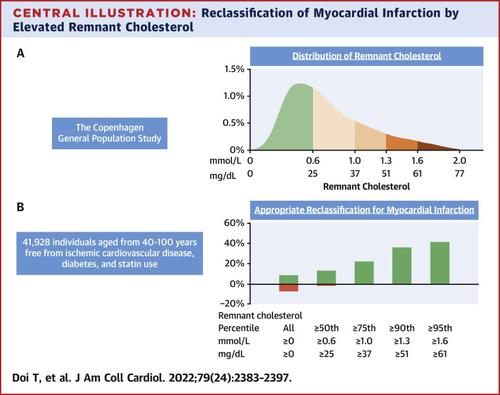当前位置:
X-MOL 学术
›
J. Am. Coll. Cardiol.
›
论文详情
Our official English website, www.x-mol.net, welcomes your
feedback! (Note: you will need to create a separate account there.)
Elevated Remnant Cholesterol Reclassifies Risk of Ischemic Heart Disease and Myocardial Infarction
Journal of the American College of Cardiology ( IF 21.7 ) Pub Date : 2022-06-13 , DOI: 10.1016/j.jacc.2022.03.384 Takahito Doi 1 , Anne Langsted 2 , Børge G Nordestgaard 2
Journal of the American College of Cardiology ( IF 21.7 ) Pub Date : 2022-06-13 , DOI: 10.1016/j.jacc.2022.03.384 Takahito Doi 1 , Anne Langsted 2 , Børge G Nordestgaard 2
Affiliation

|
Elevated remnant cholesterol causes ischemic heart disease. We tested the hypothesis that the inclusion of elevated remnant cholesterol will lead to appropriate reclassification of individuals who later experience myocardial infarction and ischemic heart disease. For >10 years we followed up 41,928 white Danish individuals from the Copenhagen General Population Study without a history of ischemic cardiovascular disease, diabetes, and statin use. Using predefined cut points for elevated remnant cholesterol, we calculated net reclassification index (NRI) from below to above 5%, 7.5%, and/or 10% 10-year occurrence of myocardial infarction and ischemic heart disease defined as a composite of death from ischemic heart disease, myocardial infarction, and coronary revascularization. For individuals with remnant cholesterol levels ≥95th percentile (≥1.6 mmol/L, 61 mg/dL), 23% ( < 0.001) of myocardial infarction and 21% ( < 0.001) of ischemic heart disease were reclassified correctly from below to above 5% for 10-year occurrence when remnant cholesterol levels were added to models based on conventional risk factors, whereas no events were reclassified incorrectly. Consequently, the addition of remnant cholesterol levels yielded NRI of 10% (95% CI: 1%-20%) for myocardial infarction and 5% (95% CI: −3% to 13%) for ischemic heart disease. Correspondingly, when reclassifications were combined from below to above 5%, 7.5%, and 10% risk of events, 42% ( < 0.001) of individuals with myocardial infarction and 41% ( < 0.001) with ischemic heart disease were reclassified appropriately, leading to NRI of respectively 20% (95% CI: 9%-31%) and 11% (95% CI: 2%-21%). Elevated remnant cholesterol levels considerably improve myocardial infarction and ischemic heart disease risk prediction.
中文翻译:

残余胆固醇升高重新分类缺血性心脏病和心肌梗塞的风险
残余胆固醇升高会导致缺血性心脏病。我们测试了这样的假设:纳入升高的残余胆固醇将导致对后来经历心肌梗塞和缺血性心脏病的个体进行适当的重新分类。我们对哥本哈根普通人口研究中的 41,928 名丹麦白人进行了超过 10 年的跟踪调查,他们没有缺血性心血管疾病、糖尿病和他汀类药物使用史。使用针对残余胆固醇升高的预定义切点,我们计算了净重分类指数 (NRI),从低于 5%、7.5% 和/或 10% 的 10 年心肌梗死和缺血性心脏病的发生率(定义为因死亡而死亡的复合疾病)缺血性心脏病、心肌梗塞和冠状动脉血运重建。对于残余胆固醇水平≥95%(≥1.6 mmol/L,61 mg/dL)的个体,23% (< 0.001) 的心肌梗塞和 21% (< 0.001) 的缺血性心脏病被正确地从低于 5 重新分类为高于 5当残余胆固醇水平添加到基于传统风险因素的模型中时,10 年发生率的百分比,而没有事件被错误地重新分类。因此,添加残余胆固醇水平后,心肌梗塞的 NRI 为 10%(95% CI:1%-20%),缺血性心脏病的 NRI 为 5%(95% CI:-3% 至 13%)。相应地,当重新分类从低于 5%、7.5% 和 10% 的事件风险组合到高于 5%、7.5% 和 10% 的事件风险时,42% (< 0.001) 的心肌梗死患者和 41% (< 0.001) 的缺血性心脏病患者被适当地重新分类,导致与 NRI 分别为 20%(95% CI:9%-31%)和 11%(95% CI:2%-21%)。残余胆固醇水平升高可显着改善心肌梗塞和缺血性心脏病的风险预测。
更新日期:2022-06-13
中文翻译:

残余胆固醇升高重新分类缺血性心脏病和心肌梗塞的风险
残余胆固醇升高会导致缺血性心脏病。我们测试了这样的假设:纳入升高的残余胆固醇将导致对后来经历心肌梗塞和缺血性心脏病的个体进行适当的重新分类。我们对哥本哈根普通人口研究中的 41,928 名丹麦白人进行了超过 10 年的跟踪调查,他们没有缺血性心血管疾病、糖尿病和他汀类药物使用史。使用针对残余胆固醇升高的预定义切点,我们计算了净重分类指数 (NRI),从低于 5%、7.5% 和/或 10% 的 10 年心肌梗死和缺血性心脏病的发生率(定义为因死亡而死亡的复合疾病)缺血性心脏病、心肌梗塞和冠状动脉血运重建。对于残余胆固醇水平≥95%(≥1.6 mmol/L,61 mg/dL)的个体,23% (< 0.001) 的心肌梗塞和 21% (< 0.001) 的缺血性心脏病被正确地从低于 5 重新分类为高于 5当残余胆固醇水平添加到基于传统风险因素的模型中时,10 年发生率的百分比,而没有事件被错误地重新分类。因此,添加残余胆固醇水平后,心肌梗塞的 NRI 为 10%(95% CI:1%-20%),缺血性心脏病的 NRI 为 5%(95% CI:-3% 至 13%)。相应地,当重新分类从低于 5%、7.5% 和 10% 的事件风险组合到高于 5%、7.5% 和 10% 的事件风险时,42% (< 0.001) 的心肌梗死患者和 41% (< 0.001) 的缺血性心脏病患者被适当地重新分类,导致与 NRI 分别为 20%(95% CI:9%-31%)和 11%(95% CI:2%-21%)。残余胆固醇水平升高可显着改善心肌梗塞和缺血性心脏病的风险预测。









































 京公网安备 11010802027423号
京公网安备 11010802027423号